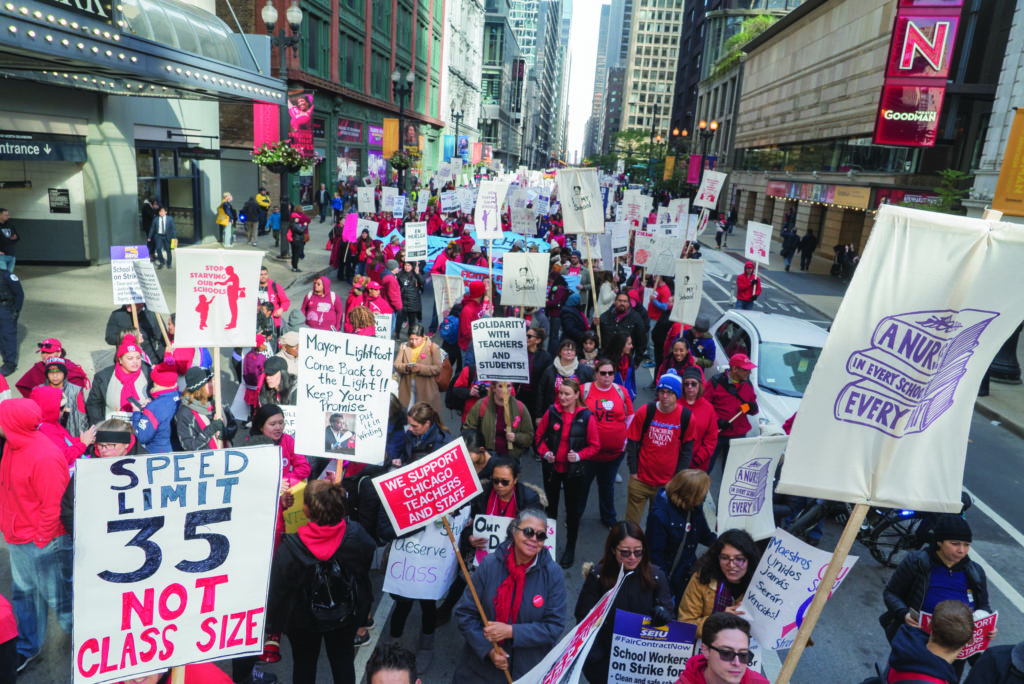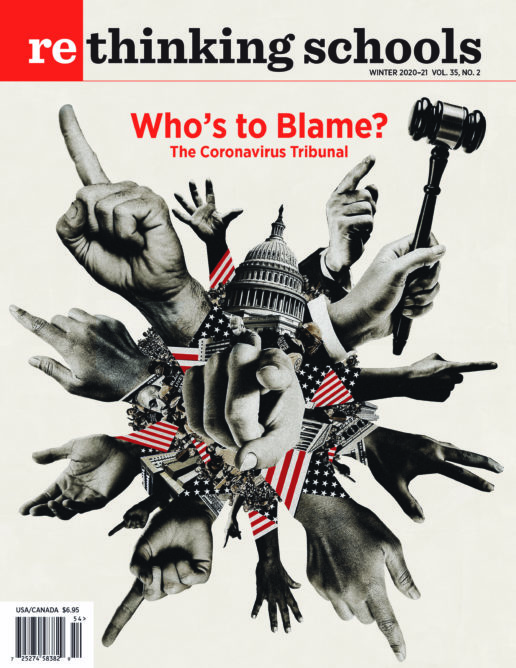Moving Past the Trump Presidency — The Promise of Social Justice Teacher Unions
Illustrator: Joe Brusky

In Rethinking Schools’ newly published book Teacher Unions and Social Justice: Organizing for the Schools and Communities Our Students Deserve, more than 40 teachers, activists, and scholars articulate a vision of teacher unionism that can play a vital role in helping public education heal from the poisonous rhetoric and policies of the Trump administration.
Trump’s avalanche of white supremacist, misogynist, and xenophobic lies normalized hatred and had a profound impact on millions of young people. Whether it was chanting “Build the Wall” in the gymnasium, telling classmates to “go back to Africa,” or insisting they would be deported, white students often aimed racial venom at students of color. At the end of his tenure, Trump sought to supercharge his sanitized version of America’s past through an initiative to whitewash any reckoning with racism or help students construct a critically balanced understanding of our history.
In the realm of education policy, Trump’s Secretary of Education Betsy DeVos reversed progressive policies on sexual assault and transgender students, tried to stop financial aid to states that implemented anti-racist training, promoted for-profit colleges and privatization of public schools, and threatened to cut aid to districts that don’t fully open their schools in the midst of the most devastating pandemic in a century.
Moving Beyond Trumpism by Nurturing the Organizing Tradition
Both the American Federation of Teachers (AFT) and the National Education Association (NEA) are lobbying for the Biden administration and Congress to fulfill promises to undo much of the damage of the Trump administration by increasing funding and support for public schools in title programs, special education, bilingual education, school integration, COVID-19 relief, and infrastructure. Fulfillment of such promises will go far in enabling school districts to pay for the schools our students deserve.
Traditional lobbying, the historically favored approach of both unions for the past four decades, will not be enough to achieve vital educational goals.
But traditional lobbying, the historically favored approach of both unions for the past four decades, will not be enough to achieve vital educational goals. We need a multifaceted approach that ensures that policy engagement with politicians is buttressed by robust rank-and-file activism based on new ideas about how to engage union members and transform the role of teachers and teacher unions in our schools. It wasn’t just lobbying that won educators pay raises in West Virginia, Arizona, and Oklahoma in the spring of 2018. The “red state revolt,” as it came to be known, showed the ultimate power of educator unions is in their ability to organize, build alliances, and strike — even in states where striking is illegal.
Moreover, the strikes and walkouts showed the tremendous capacity of rank-and-file teachers, many of whom had not been previously active in their locals, to creatively invent and embrace new ways to network and exercise shared leadership. Writing about the West Virginia strike in Teacher Unions and Social Justice, journalist Eric Blanc notes “Facebook made it much easier to communicate and mobilize large groups of people without, as in the past, having to undertake the arduous task of building up a well-resourced organizational infrastructure. It also changed the relationship and power dynamic between rank-and-file educators and their union leaderships; without having to rely on official union channels, individual teachers from far-flung counties were easily able to share with each other their concerns, information, and ideas.”
Social Justice Unionism
Traditional models of unionism — whether called “business,” “service,” or “industrial” unionism — have gained teachers important due process rights and better working conditions, wages, and benefits. But they have fallen short in empowering members and steadfastly fighting to provide all students with a high-quality education. Since the early 1990s, a growing network of teacher union activists worked to transform their locals into social justice unions that build upon the strengths of traditional models — solidarity and steadfast advocacy for teacher rights, but move on to forge something new.
In Teacher Unions and Social Justice, we present a full picture of how a social justice perspective can guide all of the work of a teacher union, encompassing wages and working conditions, professional and pedagogical issues, internal union matters, collective bargaining, and broad policy concerns. This comprehensive approach should be animated by efforts to:
- Be democratic, engage members in imaginative ways, promote internal dialogue and debate, and resist top-down control by staff or elected leaders.
- Listen to and build strong ties with students, families, civic and faith-based groups, and oppressed communities — at the school, district, and state levels — promoting educational justice and full funding for the schools and communities our students deserve.
- Challenge union members to internalize anti-racist, anti-oppression values and to teach from a social justice, anti-racist viewpoint, using restorative practices instead of punitive approaches that feed the school-to-prison pipeline.
- Reclaim our profession and our classrooms from the corporate reform agenda of standardized testing, scripted curriculum, and top-down control.
- Fight against school privatization and promote public community schools as an alternative, envisioning such schools as greenhouses of democracy and centers of resistance and renaissance in our neighborhoods.
- Be internationalist — promote teaching and policies that are opposed to war and imperialism, in favor of climate justice and human rights, and in solidarity with the Global South.
During the past several years, locals around the country have learned to enact the core elements of social justice unionism. For example, the experience of teacher unions in Los Angeles and Chicago shows that strikes that bargain for the common good and engender broad community support can address some of these important social justice issues, such as ending “random” searches of mostly Black and Brown students by police, winning a legal defense fund for undocumented students, getting a nurse for every school, demanding affordable housing in the city, and more. “Because the strike brought out public opinion in support of our issues,” writes Arlene Inouye, secretary of United Teachers Los Angeles (UTLA), “we were able to leverage that at the end to get things we would never get before.”
Building public support is more than a public relations campaign. Members of the CTU and UTLA worked for months and years building relationships with families and community members and listening to their concerns and demands. The unions used a variety of tactics and strategies to methodically build member and community support and to gauge the level of support for more dramatic actions leading up to their strikes. Central to these efforts was the call for both union and community to demand the schools and communities our students deserve, and to collaboratively decide upon and fight for concrete policies to make that demand a reality.
Building public support is more than a public relations campaign. Members of the CTU and UTLA worked for months and years building relationships with families and community members and listening to their concerns and demands.
In our book, Jackson Potter, an activist teacher leader in the Chicago Teachers Union, summed up the CTU’s work reflecting on several strikes: “Throughout history, social movement struggles have always been protracted. It’s taken three contract cycles for the CTU to turn back nearly 40 years of attacks on our public schools. It’s a shift made possible through strike action coupled with a burgeoning national teachers’ movement — and taking risks to lift up working-class and racial justice demands that go far beyond traditional collective bargaining.”
Rapid Response to Racism
A key feature of social justice unionism should be supporting educators and schools that have the courage to teach about racial, social, and climate justice, but who meet resistance from white supremacists and science deniers. Locals need to take the lead in both developing social justice curricula and defending teachers who are unfairly attacked or disciplined for taking up social justice issues in the classroom. Even in some of the most conservative areas, there is a growing sentiment, albeit small, that issues of white supremacy and related social problems must be addressed. The multiracial nature of the Black Lives Matter protests is one indication of this. In such cases, building anti-racist alliances with faith-based groups and parent and civic organizations can provide much needed support to teachers who are criticized or attacked.
Repairing the damage of Trump’s four-year reign of white nationalism and the preceding eight years of neoliberal educational “reforms” — massive standardized testing and funding of private charter schools — will not happen overnight. As Bob Dylan puts it, we’ll need to “shake the windows and rattle the walls” of politicians and policymakers. We will need activism on the streets and in school boards, city councils, statehouses, and Congress. We will need the hard work of one-on-one organizing, building popular power at the school level, engaging in issue campaigns and electing candidates to public offices who are visionary and principled and connected to social justice movements.
As Noah Karvelis, co-founder of Arizona Teachers United during the red state revolts reflects in Teacher Unions and Social Justice, “Across the nation, we have seen the power of teachers when they unite and fight for what they believe in. And as conservative and neoliberal attacks on our schools continue, it only becomes clearer that there is no hero waiting in the wings to save us. Teachers themselves must become the very leaders who will save our schools. And there isn’t a second to lose. It is time to fight back.”
Teacher unions are strategically positioned to fight back, to help lead these struggles in our communities, and to be allies in the social justice movements. More than 5 million NEA and AFT members engage daily with students and their families. They are well placed to understand and help meet the social and economic challenges the majority of people face. We believe that to provide such leadership it’s essential for teacher unions — from the smallest local to our national organizations — to embrace social justice unionism. To build the broad social movements we need, we must ensure democratic practices inside our unions, engage and organize — not just mobilize — our membership, and build lasting alliances with other labor, community, faith-based, civic, parent, and student groups.
Our students deserve nothing less.
Support independent, progressive media and subscribe to Rethinking Schools at www.rethinkingschools.org/subscribe

